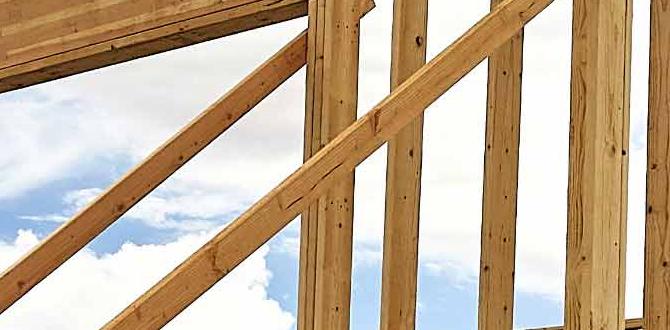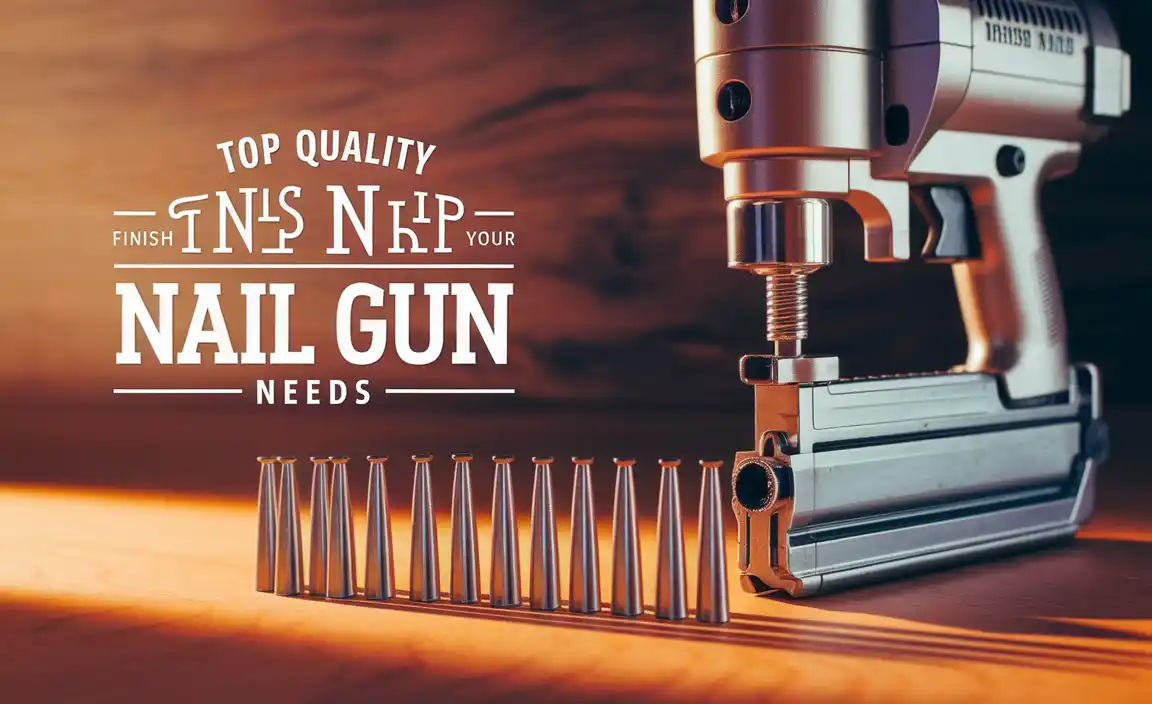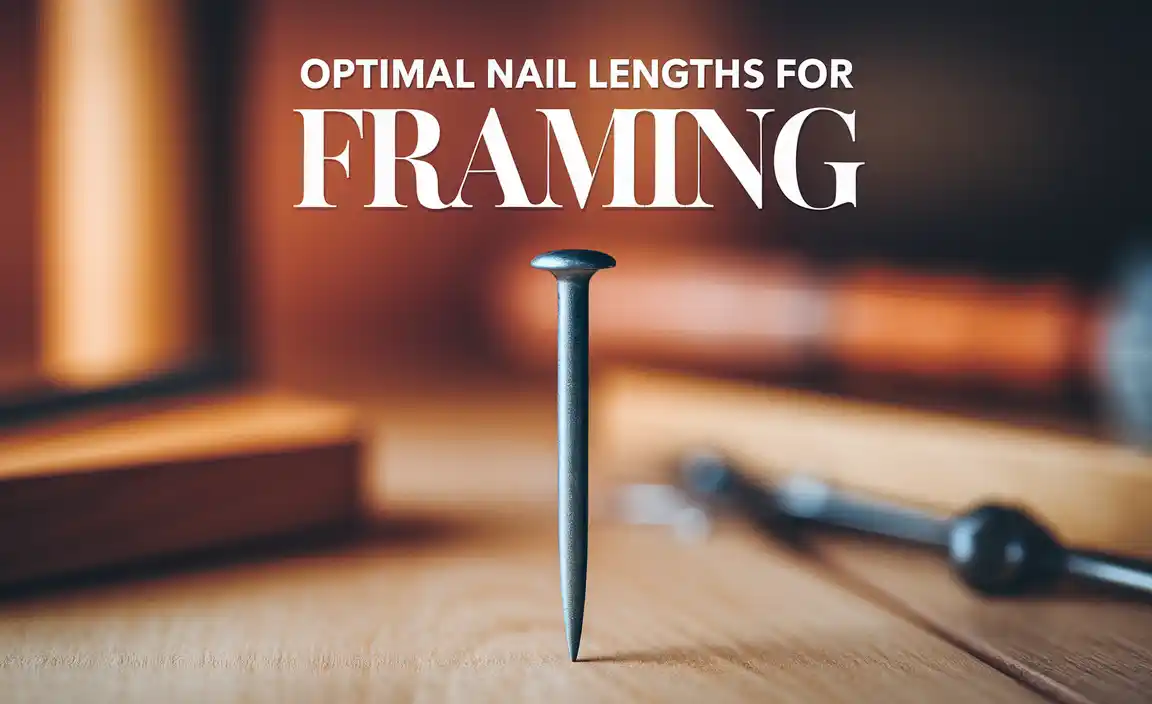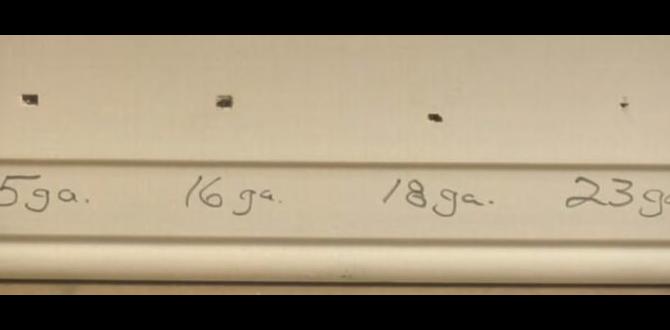Have you ever tried hanging a picture on the wall, only to watch it tilt and tumble down? Well, choosing the right size finish nails for baseboards is just as important. Imagine if your baseboards wobbled like jelly because the nails were too small. Not a pretty sight, right?
Many people wonder, “What size finish nails should I use for baseboards?” The answer can make a big difference in how your room looks and feels. Picture a strong and neat baseboard, standing straight and firm. This means using the perfect size nails.
Here’s a fun fact: The size of the nail might seem small, like a detail no one notices, but it’s key to a sturdy and appealing home. Who knew something so tiny could hold such importance in home design?
So, are you ready to find out which finish nails will keep your baseboards in perfect shape? Let’s explore this together and make sure your home looks just as you dreamed.
Table of Contents
Choosing The Right Size Finish Nails For Baseboard
Why do some baseboards look flawless while others don’t? It’s all about using the right size finish nails. For most baseboards, 15 or 16-gauge nails work best. They’re thick enough to hold the wood but not so big that they split it. Picture this: you’re hammering away, and suddenly, the finish looks perfect.
What matters is choosing nails that let the baseboard sit snugly against the wall. Have you ever seen wavy baseboards? Those happen because the nails weren’t chosen wisely. With the right size, your baseboard will stay secure and look professional. Always remember that the choice of nail size makes a big difference in achieving that smooth, sophisticated finish you want.
Understanding Finish Nails and Their Uses
Definition and purpose of finish nails. Different types of finish nails.
Finish nails are small, round-headed nails used for carpentry jobs. They are great for attaching trim, molding, or baseboards because they don’t leave big holes. This makes them a favorite among builders. Finish nails come in different types like bright, galvanized, or stainless steel.
- Bright: These are ideal for indoor projects.
- Galvanized: Good for outdoor work, as they resist rust.
- Stainless Steel: Highly resistant to corrosion, perfect for high-moisture areas.
Which finish nails are best for baseboards?
For baseboards, using finish nails that are 16-gauge and 1.5 to 2.5 inches long works best. They offer enough strength to hold the board securely but don’t cause splitting. Baseboards benefit from precision work, so choosing the right finish nails is important.
Factors to Consider When Choosing Nail Size for Baseboards
Material of baseboard. Thickness and density considerations. Aesthetic preferences.
Picking the right nail size for your baseboards can be a tricky task. First, think about the material of your baseboard. Softwood? You’ll need a smaller nail. Hardwood? Go bigger! Thickness and density also matter. A thicker board needs a longer nail to hold it tight. Don’t forget the aesthetic too! Do you want the nails to be the star of the show? I didn’t think so! Choose a size that blends in seamlessly and keeps everything in place. Remember, a pretty baseboard is a happy baseboard!
| Factor | Consideration |
|---|---|
| Material | Softer materials use smaller nails; harder materials use larger ones. |
| Thickness & Density | Thicker and denser boards require longer nails. |
| Aesthetic | Choose a discreet nail size for an elegant finish. |
Recommended Nail Sizes for Baseboards
Common nail sizes and their applications. Pros and cons of different sizes.
Choosing the right nail size for baseboards is important. Common sizes include 1.5 inches, 2 inches, and 2.5 inches nails. Each has its unique uses.
- 1.5-inch nails: Great for attaching thinner boards. They avoid splitting but may not be secure enough for thicker wood.
- 2-inch nails: Perfect middle-ground for most baseboards. They provide a good hold without the risk of causing damage.
- 2.5-inch nails: Best for very thick baseboards. They ensure a strong hold but can sometimes be tricky to remove.
Using the right size makes the job easier and the baseboards last longer!
How do you know which nail size to use for baseboards?
Check the thickness of the baseboard. Thinner boards need smaller nails, and thicker boards need larger ones. A general rule is to use a nail that is three times the thickness of the material you are nailing into.
Tools Required for Nailing Baseboards
Types of nail guns suitable for finish nails. Additional tools and accessories.
Imagine you’re about to nail some baseboards. First, you need super cool tools! Types of nail guns? Well, there’s the finish nailer. It’s your best buddy for the job, shooting nails in like a ninja! You might also consider a brad nailer for precision.
Wait, don’t forget your safety gear! Goggles and gloves are a must to keep those fingers intact. Also, grab a tape measure and a level. They’re like secret agents in disguise, making sure everything lines up perfectly. Need more? Check out this simple table:
| Tool | Purpose |
|---|---|
| Finish Nailer | For shooting finish nails |
| Brad Nailer | Great for precise nailing |
| Goggles & Gloves | Safety first! |
| Tape Measure & Level | Ensures straight lines |
Remember, Grandma always said, “Measure twice, nail once!” With these tools, your baseboard project will be a breeze!
Step-by-Step Guide to Installing Baseboards with Finish Nails
Preparation steps before installation. Correct nailing techniques.
Before you start putting up baseboards, be sure you gather all the necessary tools. A tape measure, saw, and finish nails are key. Measure the walls to find the right lengths for your baseboards. Preparing correctly makes the job easier and cleaner.
- Use a tape measure to note accurate lengths.
- Cut baseboards to these lengths.
For nailing, hold the baseboard tight against the wall. Use your nail gun to place nails at angles. This holds the board in place better.
- Angle nails to secure the board.
- Space nails about 16 inches apart for strength.
### **What size finish nails are best for baseboards?**
2-inch nails work best for most baseboards. These nails hold the boards securely without splitting them.
Common Mistakes to Avoid When Using Finish Nails
Misjudging nail size. Improper spacing and placement.
Avoiding mistakes with finish nails can prevent damage to your baseboards. Here’s how:
- Misjudging nail size: Picking the wrong size nail can cause cracks. Choose nails that are long enough to hold but not too thick.
- Improper spacing and placement: Place nails evenly. Too far apart, and the baseboard may come loose; too close, and it can crack.
What size finish nails should you use for baseboards?
Choose 1.5-inch to 2-inch nails. This size fits most standard baseboards. They offer a firm hold without splitting the wood.
Alternative Fastening Methods for Baseboards
Other types of nails and fasteners. Adhesive options and when to use them.
You can use various fasteners for baseboards instead of finish nails. Here are some options:
- Brads: These are tiny nails, strong enough for light baseboards.
- Screws: Use them for a tighter hold. They are best for thicker boards.
- Construction adhesive: This sticky paste holds baseboards in place. Use it on walls where nails can’t be used.
Choosing the right tool depends on your wall and baseboard type. Always check what works best for your project.
Can you use glue for baseboards?
Yes, you can use glue for baseboards. Glue is great for walls that can’t be nailed. It works best on smooth surfaces. Remember, glue needs time to dry. Make sure the baseboards stay in place while the glue sets.
Conclusion
Choosing the right finish nail size for baseboards is key. Use 15-18 gauge nails, usually 1.5-2 inches long. This ensures strong hold without damaging the wood. When you’re ready to start your project, keep these sizes in mind for a neat finish. Explore more guides to boost your DIY skills further.
FAQs
What Is The Recommended Finish Nail Gauge For Installing Baseboards?
When you are putting up baseboards, use finish nails that are size 15 or 16 gauge. These nails are the right size to hold the baseboards in place without splitting the wood. They are strong enough to keep the baseboards secure. So, remember, size 15 or 16 gauge is best!
How Long Should Finish Nails Be When Attaching Baseboards To The Wall?
When you attach baseboards to the wall, use finish nails that are about 1.5 to 2 inches long. This length helps the nails hold the baseboards firmly. If the nails are too short, the baseboards might not stay in place. If they’re too long, they might stick out of the wall.
Are 16-Gauge Finish Nails Suitable For Baseboard Installation, Or Should I Use A Different Size?
Yes, you can use 16-gauge finish nails for baseboards. They are strong enough to hold the wood in place. These nails are thick and will do a good job. Make sure to use a nail gun to push them in evenly.
Can I Use 18-Gauge Brad Nails Instead Of Finish Nails For Baseboard Trim, Or Will That Affect The Hold?
You can use 18-gauge brad nails for baseboard trim, but they might not hold as well as finish nails. Brad nails are thinner and less sturdy. Finish nails are thicker and hold the trim better. It’s important to choose the right nail for the best results.
What Factors Should I Consider When Choosing The Right Size Finish Nails For My Baseboard Project?
When picking finish nails for your baseboard, think about three things. First, check the thickness of your baseboard. Second, make sure your nails are long enough to go through the baseboard and grab the wall. Lastly, consider the type of wall, like wood or drywall, since it might need different lengths of nails.





